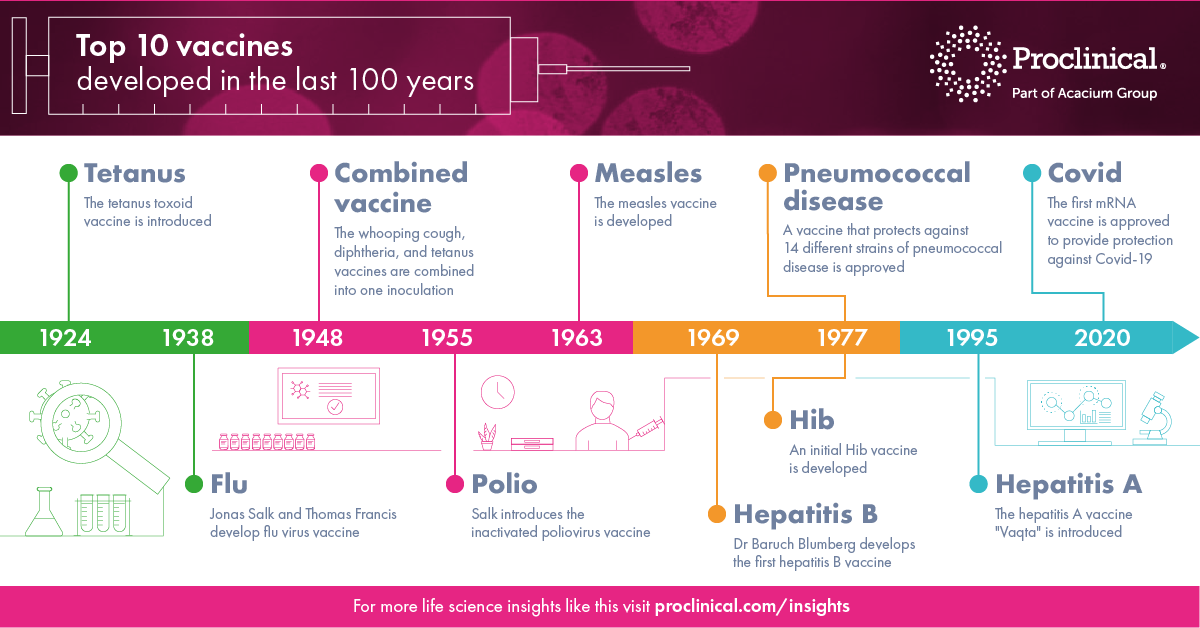
For hundreds of years, humans have looked for ways to protect against deadly diseases and stop global pandemics taking hold. In 1796, physician and scientist, Edward Jenner, made a major medical advancement when he developed the world's first successful vaccine, which protected against Smallpox.
Since then, a range of game-changing inoculations have been introduced, ending pandemics and saving lives across the world. We have listed the most important vaccines in history, focusing on those developed in the last 100 years.
10 of the most important vaccines in history
1924 - Tetanus Toxoid
In the early 1920s, a method for inactivating tetanus toxin with formaldehyde was developed which later resulted in the introduction of the tetanus toxoid vaccine in 1924. The inoculation was first widely used in World War II to protect soldiers and its widespread use resulted in a 95% decrease in the rate of tetanus. Today, tetanus toxoid vaccines are typically recommended for children and adults and booster doses of tetanus toxoid are administered every 10 years to maintain immunity.
1938 - Flu virus
In the early 1930s, British researchers Wilson Smith, C.H. Andrewes and P.P. Laidlaw made a breakthrough when they found no bacteria in throat washings from patients with influenza and discovered that the disease was caused by a virus. After this discovery, Jonas Salk and Thomas Francis went on to develop the first flu vaccine in history. With support from the army, the inoculation was first tested for safety and efficacy on the US military before being approved for wider use in 1945.
1948 - Whooping cough, diphtheria, and tetanus
In the 1940s, scientists recognised the benefits of merging three vaccines into one, and the DTP (diphtheria, tetanus, and pertussis) combined vaccine was introduced. The combination vaccine was first administered in 1948 and became FDA approved in the US a year later. It quickly became a routine childhood vaccine. It was used until 1991 when the diphtheria-tetanus-acellular pertussis (DTaP) vaccine was introduced, which was found to cause fewer side effects and was deemed to be safer than DTP. Since the combination vaccine was first rolled out, it has had a significant impact on public health worldwide, significantly reducing incidences of diphtheria, tetanus, and pertussis, saving thousands of lives.
1955 - Poliovirus
Polio (poliomyelitis) is a disabling and life-threatening disease that can infect a person's spinal cord and cause paralysis. Before polio vaccines were available, outbreaks caused thousands of cases of paralysis each year globally. In the early 20th century, several researchers made significant contributions to the development of polio vaccines. By the 1950s, Jonas Salk and his team made a breakthrough, when they discovered a vaccine that killed strains of all three types of poliovirus (poliovirus types 1, 2, and 3). Large-scale clinical trials took place, known as the "Polio Pioneers" trial, and in 1955, it was deemed safe and highly effective in preventing polio.
1963 - Measles
The first measles vaccine in history was rolled out when virologist John F. Enders and his team of researchers discovered they could successfully isolate the measles virus and use it to create a weakened form of the virus for inoculation purposes. The vaccine was found to stimulate the immune system to produce antibodies that provided long-term immunity against measles. Since it was released in the 1960s, measles has been eradicated in many countries and regions worldwide. However, outbreaks still occur in areas with lower vaccination rates or in groups of susceptible populations.
1969 - Hepatitis B
The hepatitis B virus was first identified in 1960s, and it was identified as a significant cause of liver disease, making it a concern for global health. In 1969, Dr Baruch Blumberg discovered a protein on the surface of the hepatitis B virus, known as the hepatitis B surface antigen (HBsAg). This discovery laid the foundation for the development of the important hepatitis B vaccine. The introduction of recombinant DNA technology, in the early 1980s, transformed vaccine production as scientists were able to clone the gene responsible for HBsAg production, allowing them to produce the protein in large quantities. Today, the recombinant hepatitis B vaccine is an integral part of immunization programs worldwide and has greatly reduced the incidence of new infections globally.
1977 - Pneumococcal
In the late 19th century, Pneumococcus was identified as a major cause of pneumonia by Dr Louis Pasteur and Dr George Miller Sternberg. By 1977, the first pneumococcal polysaccharide vaccine in history was licensed for use in the United States. It contained purified capsular polysaccharide antigen from 14 different strains of pneumococci, protecting patients from contracting pneumonia.
1977 - Haemophilus influenzae type b
Haemophilus influenzae type b (Hib) is a type of bacteria that can cause life-threatening infections, including meningitis. In 1977, scientists made an important breakthrough in understanding the biology of Hib and its capsule, a key virulence factor. They developed methods to produce a purified polysaccharide from the Hib capsule, which was used as a base for the initial Hib vaccine. Since then, several generations of Hib vaccines with improved safety and ease of administration have been developed. Today, these vaccines are usually given in a series of doses to infants, starting when they are just months old.
1995 - Hepatitis A
Hepatitis A is an inflammation of the liver caused by the hepatitis A virus (HAV). It is transmitted through ingestion of contaminated food and water or through direct contact with an infectious person. It can lead to serious health problems, such as organ failure. Before the vaccine, the main ways of preventing hepatitis A were hygienic measures and passive protection with immune globulin. The hepatitis A (HepA) vaccine, known as Vaqta, was produced by Maurice Hilleman and his team at one the leading pharma companies, Merck & Co. This was first licenced for use in the United States in 1995. The vaccine provides long-term protection against the hepatitis A virus and was phased in for those living in high-risk areas. By the turn of the millennium, the Hep A and Hep B vaccines were combined into one inoculation, known as Twinrix. Having these combined has lowered administrative costs and improved the uptake of the vaccine.
2020 - Covid-19
When the Covid-19 pandemic swept across the globe at the end of 2019 and early 2020, pharmaceutical companies raced to find a vaccine that would protect against the virus. By November 2020, encouraging results from phase III clinical trials started to emerge. Notably, Pfizer-BioNTech and Moderna reported high efficacy rates for their mRNA-based vaccines and by December 2020, regulatory agencies, such as the U.S. Food and Drug Administration (FDA), the European Medicines Agency (EMA), and others, granted Emergency Use Authorization (EUA) or conditional approvals for the Pfizer-BioNTech and Moderna vaccines, allowing their widespread use. Other leading pharma companies, such as AstraZeneca and Johnson & Johnson later went on to roll out their vaccines, demonstrating the power of collaboration, innovation, and global cooperation in addressing public health emergencies.
The fast delivery of the world’s first mRNA-based vaccine, for Covid19, put a spotlight on mRNA technology. With their high effectiveness, capacity for fast development, and potential for low production costs, mRNA vaccines offer a lot of promise for the future of vaccines.
Found this article on the most important vaccines in history interesting? Find out more about the development of medical advancements by checking out our blog: Top 10 most important drugs in history

.png)

.png)


.png)
.png)




.png)
.png)












